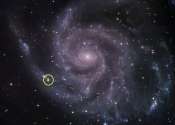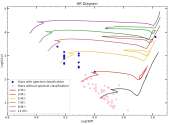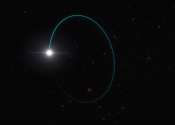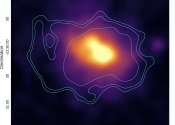Last update:
Astronomy news

NASA's Fermi mission sees no gamma rays from nearby supernova
A nearby supernova in 2023 offered astrophysicists an excellent opportunity to test ideas about how these types of explosions boost particles, called cosmic rays, to near light-speed. But surprisingly, NASA's Fermi Gamma-ray ...
Astronomy
10 minutes ago
0
0

Citizen science project classifying gamma-ray bursts
When faraway stars explode, they send out flashes of energy called gamma-ray bursts that are bright enough that telescopes back on Earth can detect them. Studying these pulses, which can also come from mergers of some exotic ...
Astronomy
31 minutes ago
0
0

A solar neighborhood census, thanks to NASA citizen science
To take a census of nearby cosmic objects, sending out a survey won't work. Scientists need to use many telescopes with different specializations to chart what is in the general neighborhood of the sun.
Astronomy
1 hour ago
1
7

Why figuring out how potassium is destroyed in stars is important to understanding the universe
If you want to know where elements come from, look to the stars. Almost every element heavier than helium is formed through nuclear reactions in stars. But which stellar processes are responsible for these elements? Can we ...
Astronomy
3 hours ago
0
16

Astronomers inspect open cluster Berkeley 50
Using the Lowell Discovery Telescope (LDT), astronomers from the Lowell Observatory in Flagstaff, Arizona, have observed a young Galactic open cluster known as Berkeley 50. Results of the observational campaign, presented ...

Most massive stellar black hole in our galaxy found
Astronomers have identified the most massive stellar black hole yet discovered in the Milky Way galaxy. This black hole was spotted in data from the European Space Agency's Gaia mission because it imposes an odd 'wobbling' ...
Astronomy
10 hours ago
1
208

Rubin observatory will reveal dark matter's ghostly disruptions of stellar streams
Glittering threads of stars around the Milky Way may hold answers to one of our biggest questions about the universe: what is dark matter? With images taken through six different color filters mounted to the largest camera ...
Astronomy
19 hours ago
1
38

The brightest gamma ray burst ever seen came from a collapsing star
After a journey lasting about two billion years, photons from an extremely energetic gamma-ray burst (GRB) struck the sensors on the Neil Gehrels Swift Observatory and the Fermi Gamma-Ray Space Telescope on October 9th, 2022. ...
Astronomy
23 hours ago
0
75

Formation-flying spacecraft could probe the solar system for new physics
It's an exciting time for the fields of astronomy, astrophysics, and cosmology. Thanks to cutting-edge observatories, instruments, and new techniques, scientists are getting closer to experimentally verifying theories that ...
Astronomy
23 hours ago
0
37

Neutron stars could be heating up from dark matter annihilation
One of the big mysteries about dark matter particles is whether they interact with each other. We still don't know the exact nature of what dark matter is. Some models argue that dark matter only interacts gravitationally, ...
Astronomy
23 hours ago
0
10

Hydrogen recombination found to be most plausible explanation for high levels of energy in stellar superflares
Although their primary purpose is to look for exoplanets, observatories like the Kepler Space Telescope and the Transiting Exoplanet Survey Satellite (TESS) have supplied a vast amount of data on stellar flares, detected ...
Astronomy
Apr 15, 2024
0
214

Astronomers detect radio halo in a massive galaxy cluster
An international team of astronomers has performed radio observations of a massive galaxy cluster known as ACT-CL J0329.2-2330, which resulted in the detection of a new radio halo in this cluster. The finding was reported ...

Physicists solve puzzle about ancient galaxy found by Webb telescope
Last September, the James Webb Space Telescope, or JWST, discovered JWST-ER1g, a massive ancient galaxy that formed when the universe was just a quarter of its current age. Surprisingly, an Einstein ring is associated with ...
Astronomy
Apr 13, 2024
7
528

Fast radio bursts: Research introduces a novel approach to characterize their behavior
Fast radio bursts (FRBs) represent the most intense radio explosions in the universe. Since the first discovery in 2007, FRBs have garnered significant attention, culminating in the 2023 Shaw Prize in Astronomy. With yet ...
Astronomy
Apr 12, 2024
0
67

Problems with 3 Body Problem? Experts discuss physics, mathematics behind hit Netflix show
The science fiction television series 3 Body Problem, the latest from the creators of HBO's Game of Thrones, has become the most watched show on Netflix since its debut last month. Based on the bestselling book trilogy Remembrance ...
Astronomy
Apr 12, 2024
9
138

Exoplanets true to size: New model calculations shows impact of star's brightness and magnetic activity
In the constellation Virgo, 700 light years away from Earth, the planet WASP-39b orbits the star WASP-39. The gas giant, which takes little more than four days to complete one orbit, is one of the best-studied exoplanets. ...
Astronomy
Apr 12, 2024
1
93

New tidal stellar stream discovered with Gaia
By analyzing the data from ESA's Gaia satellite, Chinese astronomers have detected a new tidal stellar stream in the northern hemisphere, which has a low metallicity and a relatively high energy. The finding was reported ...

Stellar winds of three sun-like stars detected for the first time
An international research team led by a researcher from the University of Vienna has for the first time directly detected stellar winds from three sun-like stars by recording the X-ray emission from their astrospheres, and ...
Astronomy
Apr 12, 2024
0
173

Researchers confirm brightest gamma-ray burst of all time came from the collapse of a massive star
In October 2022, an international team of researchers, including Northwestern University astrophysicists, observed the brightest gamma-ray burst (GRB) ever recorded, GRB 221009A.
Astronomy
Apr 12, 2024
0
1287

Juice aces Callisto flyby test
Seven years from now, in April 2031, ESA's Juice mission will fly past Jupiter's moon Callisto, offering scientists a tantalizing glimpse at the mysterious, cratered alien world.
Astronomy
Apr 11, 2024
0
60
Other news

Researchers advance pigment chemistry with moon-inspired reddish magentas

'One ring to rule them all': How actin filaments are assembled by formins

Spiraling insights: Scientists observe mechanical waves in bacterial communities

Attosecond imaging made possible by short and powerful laser pulses

Climate-change-driven cold snaps threaten marine life

Sustainable synthesis method reveals N-hydroxy modifications for pharmaceuticals

Creating an island paradise in a fusion reactor





























































